|
| OO Scale | N Scale | G Scale | Z Scale | HO Scale | Slot Cars & R⁄C |
| |||||||
|
|||||||
| Home Page | |||||||
| BUY GIFT VOUCHERS | |||||||
| Products | |||||||
| Latest News | |||||||
| RIGHT LINES | |||||||
| Bargains | |||||||
| Downloads | |||||||
| Events | |||||||
| Careers & Jobs | |||||||
| Carriage Services | |||||||
| About Us | |||||||
| Contact Us | |||||||
| Pay Us A Visit | |||||||
| Meet The Staff | |||||||
| Links | |||||||
| SHOPPING BASKET |
Your shopping basket is empty. To add an item, click the "Buy" button
| YOUR ACCOUNT | ||
|
||||
 |
||||
| Prodigy Advance Digital System |
||||
| Cased Controllers |
||||
| Panel Mount Controllers |
||||
| Walkabout Controllers |
||||
| Modules & Transformers |
||||
| Scenics & Accessories |
||||
| Wiring & Electrical Components |
||||
| Tiny Signs | ||||
| Tools | ||||
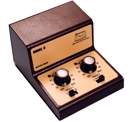 |
||||
| RECENTLY VIEWED |
| N12800 - On the Platform Sound Scene | ||
| N00260 - Spring Meadow Mid Green Grass Mat 120x60cm | ||
| PK62814 - North Pole Icicles Set | ||
| PK62228 - Red River Station Kit | ||
| PR28136 - Couple Standing Figure | ||
| More ›› |
| O Scale | Wargaming | Architectural | Narrow Gauge | Tools+ | ||
Converting a Triang Royal Mail Van Part 2

WARREN KERFOOT converts a Triang Royal Mail Van to run on modern track.
Here’s a second coach created on the back of an article regarding Royal Mail coaches being modified by using the standard Hornby and much earlier Triang TPO units. The first I showed was a sorting van, whereas this one is the larger 60ft LMS diagram stowage or tender vehicle.
This particular one means the destruction of three Triang R23 units, but hopefully the result is a model that’s a lot more pleasing to the eye, more like a prototype, more interesting and actually runs on modern track.
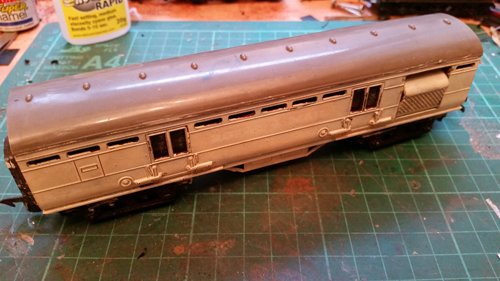
As before, this project is using these redundant old vehicles and all that’s needed in terms of tools is the GM679 Gaugemaster Razor Saw as it has a deeper cut, GM676 Mitre Box, GM608 Pliers a square and some files, plus of course a cutting mat. Not for the obvious reason of it just being a cutting mat, but the usefulness of the printed lines to keep the model square as it’s constructed bit by bit.
Again, remove the bogies first. These are fixed originally by a soft brass fixing, so just nip the rolled over edge in a few places on the bogie underside and collapse the walls inwards using the bent nose pliers. All a bit brutal but effective as these parts are scrap. Then remove the underframe. There’s two generations of these it seems, one is retained by the roof fixing screw and the other is clipped in place, though I did come across one that had been bonded. Which ever you encounter it needs to be removed and you may want to re-use it, so gently does it.
The roof is a straightforward removal and then the inner workings are exposed. The mailing unit is simply held in place by four lugs along the top of the vehicle sides. Just ease the body sides apart gently and the unit releases pretty readily. There’s three of these to do for this particular one though!
For this stowage vehicle, there are lots of cuts requiring the saw where the door recesses are going to be made. The moulded traductors are carved off initially with the trusty GM knife and then filed smooth. Same goes for the dummy side lamps and any ribbing in the moulding.
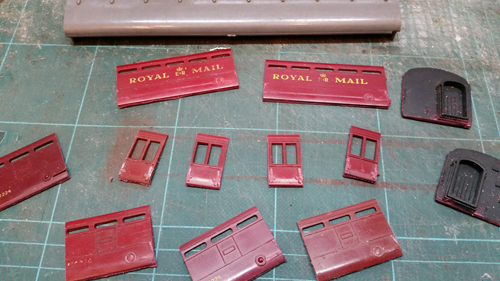
Then the cut... You pretty much need everything off the twin door side cut neatly, with the door side facing you, run down the ends, on each of the doors (very tightly into the moulding as you need the moulding either side of each cut too) and the toilet window also - just beyond the old mail drop door hole. So now you have effectively the monocoque with seven cuts from the top to the solebar.
Now run along the solebar to where it meets the tumblehome of the body side with the saw end only, (the solebar for those who maybe don’t know is the chassis frame side, in this case all one mould, but on most modern models separate and correctly painted black. The ‘tumblehome’ is the final lower curved section of a coach side before it meets the chassis solebar). Keep slicing in with the end of the saw until a defined cut starts, it’s too long to cut without this as a guide. It isn’t necessary thankfully to work all the way through - it’s just going to be a fracture line, but the cut prevents any strain going into the upper body causing a crack or distortion on the bits you want.
Looking inside now, nip off all the supporting pegs and frames for the body that are right behind the side you’ve cut. Then, section by section, push each piece backwards until it obligingly snaps clean off.
For this vehicle you do have to have a guard’s compartment, and the doors for which you can slice out of the midships doors on the sorting frame side. You have three scrap bodies... so you can have a few attempts!
Remove the ends (mirror cut of what you did down the old twin door side), then I run along just above the buffer holes and just below the corridor connector... the original author of the article I read which set this ball rolling cut the full ends off, but I wanted to make new bufferbeams and it also helps keep the body structure all at ‘one level’ as you make it back up.
Now it’s file time. Each piece needs cleaning up to remove debris and lumps. Take your time and get each piece tidy and square as it’ll make the rebuild so much easier.
This model is supposed to be 60’ in length - so 240mm in OO. It really is a crude and simple task of laying the pieces down and then slotting in bits of fill sections until your length is right and the features look to be in the right place. I made a couple of errors, but you have plenty of body moulding to play with from the leftover sides!
For regluing I use DLAD-70 Deluxe Plastic Kit Glue for these as the type of plastic responds really well to it. When all the joints and so on are cured a whip round with DLBD-44 Deluxe Perfect Plastic Putty to fill in collateral damage and any random gaps in the final fit. For this unit, there’s also windows to block out completely. the Deluxe filler does the job super quick!
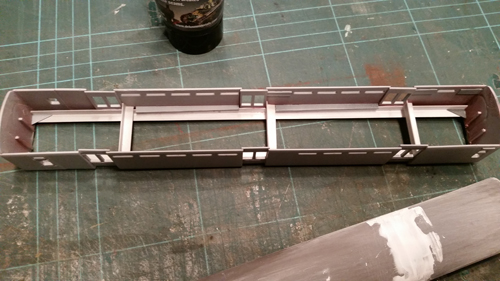
Once you have the sides and ends glued and squared up (just using the lines on the cutting mat) you have something resembling a coach with all the structural integrity of blancmange... so Plastruct angle is used to brace the inside along its length and spacers carefully measured and fitted laterally. Leave that to cure overnight ideally and you end up with a decent rigid structure.
The roof is a ‘cut and shut’ of two for the extra length, again, the Plastic Putty fills the gap nicely giving a tough flexible and smooth finish after careful sanding, with ventilators filed off and some proper ventilators refitted. I tend to leave these a bit high as I like the rooflines to have different character when in a train.
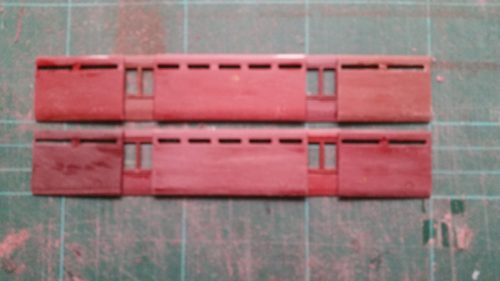
Then quickly prepare for repainting with the Gaugemaster fibre glass pencil. The GM633 red one is best and gives a brilliant key for the repaint.
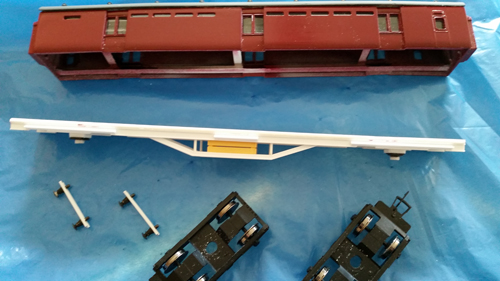
For this particular model I needed a new chassis. This is made up of 80 thou plastic card and the underframe made from various fine Plastruct. I should add here that I fitted the solebar (the chassis side) to my new body floor, however what I ended up with was too narrow and if I had 15 foot radius curves, I’d have been fine as there was virtually no articulation in the Bachmann bogies I used before it hit the frame. Beware of this if you do it!
To resolve the problem I cheated! I’d invested too much timewise to scrap the chassis, so I simply cut out ‘wheel arches’ for clearance and then made a second solebar to fit over the first. You’d never know if I hadn’t told you!
The model’s primed and then topcoated when anything too bad is dealt with. If you like the windows to look flush as I do run DLAD-55 Deluxe Glue N Glaze in over the acetate windows you’ve fitted behind and the effect is tremendous.
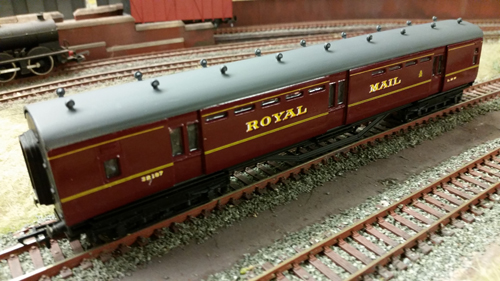
Then using HMRS PX1P LMS Coach decals for my beloved LMS, what was an unusable and crude vehicle at origin takes on it’s new guise. Not designed to be a slavish copy of it’s diagram, just to give the feel of a different unit in a Royal Mail TPO running set.
There’s going to be a few more of these vehicles in the pipeline to make tender vans in the coming weeks to make what I hope will be an attractive TPO train.
|
We are always looking to make improvements to our website to try and improve the quality of your visit. We would welcome your feedback and suggestions, so please do not hesitate to e-mail our webmaster with your comments. Alternatively call us on 01903 884488.
Home Cookies Privacy Statement Terms & Conditions Site Map Site Guide
WEEE Regulations Glossary Careers & Jobs
Tel – +44 (0) 1903 884488 Fax – +44 (0) 1903 884377 E-Mail us – click here
Gaugemaster.com is a trading name of Gaugemaster Controls Ltd.
Registered in England No. 2714470, Registered office:
Gaugemaster House, Ford Road
Arundel, West Sussex, BN18 0BN, United Kingdom
VAT Reg. No. 587 8089 71
Copyright © 2003-2014 Gaugemaster Controls Ltd. All Rights Reserved.
















